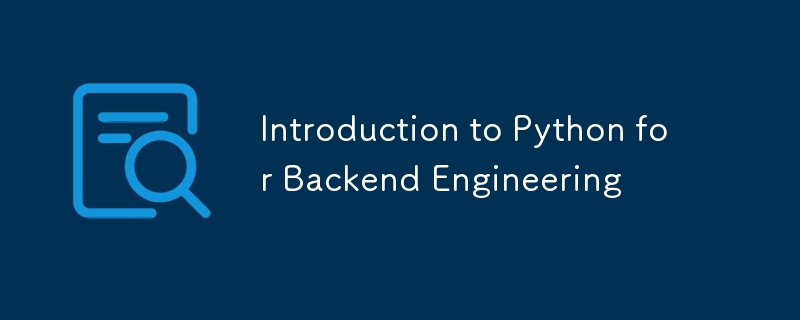Python 後端工程簡介
- WBOYWBOYWBOYWBOYWBOYWBOYWBOYWBOYWBOYWBOYWBOYWBOYWB原創
- 2024-07-25 21:22:13899瀏覽

歡迎來到我們使用 Python 和 Django 學習後端工程的系列。無論您是剛開始程式設計之旅還是希望提升自己的技能,Python 都能為您提供堅實的基礎。本介紹指南將引導您了解 Python 的基本知識,為後端開發中更進階的主題奠定基礎。
為什麼要學Python?
多功能性
Python 是一種通用語言,可用於各個領域,包括 Web 開發、數據分析、人工智慧和科學計算。其廣泛的應用使其成為任何後端工程師的寶貴技能。
易於學習
Python 簡單、類似英語的語法使其成為初學者的絕佳選擇。您可以用最少的努力編寫和理解程式碼,讓您專注於解決問題而不是破解複雜的語法。
社區支持
Python 擁有一個龐大、活躍的社群。這意味著您將可以存取大量可簡化開發的程式庫、框架和工具。此外,您還會發現大量教學、論壇和資源來為您提供協助。
職業機會
Python 開發人員在各行業都有很高的需求。學習 Python 為後端開發及其他領域的眾多職業機會打開了大門。
基本語法和結構
縮排
Python使用縮進來定義程式碼區塊,使程式碼視覺上乾淨且易於閱讀。與其他使用大括號 {} 表示區塊的語言不同,Python 依賴一致的縮排。
if condition:
# This is a code block
print("Condition is true")
變數
在Python中,你不需要明確宣告變數型別。 Python 是動態類型的,這意味著它在運行時確定變數的類型。
x = 10 name = "Python"
評論
註解對於讓你的程式碼易於理解至關重要。使用 # 符號表示單行註釋,使用三引號 ''' 或 """ 表示多行註解。
# This is a single-line comment """ This is a multi-line comment """
資料類型和結構
基本資料類型
Python 支援各種基本資料類型,包括整數、浮點數、字串和布林值。
num = 5 # Integer pi = 3.14 # Float greeting = "Hi" # String is_valid = True # Boolean
收藏
清單
列表是有序的、可變的項目集合。它們非常適合儲存資料序列。
fruits = ["apple", "banana", "cherry"] print(fruits[0]) # Outputs: apple
元組
元組是有序的、不可變的項目集合。一旦創建,其元素就無法更改。
coordinates = (10.0, 20.0) print(coordinates[1]) # Outputs: 20.0
字典
字典是鍵值對的無序集合,非常適合儲存相關資料。
person = {"name": "John", "age": 30}
print(person["name"]) # Outputs: John
套
集合是唯一項目的無序集合,可用於儲存不同的元素。
unique_numbers = {1, 2, 3, 4}
print(unique_numbers) # Outputs: {1, 2, 3, 4}
控制流語句
條件語句
使用 if、elif 和 else 根據條件執行程式碼。
age = 20
if age < 18:
print("Minor")
elif age >= 18:
print("Adult")
else:
print("Invalid age")
循環
使用 for 和 while 迴圈迭代序列或重複程式碼,直到滿足條件。
# For loop
for i in range(5):
print(i)
# While loop
age = 15
while age < 18:
print("Not an adult yet")
age += 1
功能
函數是執行特定任務的可重複使用程式碼區塊。使用 def 關鍵字定義它們。
def greet(name):
return f"Hello, {name}!"
print(greet("Alice")) # Outputs: Hello, Alice!
模組和套件
模組是包含可在其他腳本中匯入和使用的 Python 程式碼的檔案。套件是按目錄組織的模組集合,提供了一種建立大型程式碼庫的方法。
# Importing a module import math print(math.sqrt(16)) # Outputs: 4.0
錯誤處理
使用 try、 except、finally 和 else 區塊處理異常,以優雅地管理錯誤。
try:
result = 10 / 0
except ZeroDivisionError:
print("Cannot divide by zero")
finally:
print("This block always executes")
文件處理
使用 open()、read()、write() 和 close() 函數讀取和寫入檔案。
# Writing to a file
with open("example.txt", "w") as file:
file.write("Hello, World!")
# Reading from a file
with open("example.txt", "r") as file:
content = file.read()
print(content) # Outputs: Hello, World!
庫和框架
Python 廣泛的標準函式庫包括系統功能、檔案 I/O 等模組。流行的庫包括:
- NumPy:用於數值計算
- Pandas:用於資料操作和分析
- 請求:用於發出 HTTP 請求
- Matplotlib:用於資料視覺化 對於 Web 開發,廣泛使用 Django 和 Flask 等框架。
# Example using the Requests library
import requests
response = requests.get("https://api.github.com")
print(response.status_code) # Outputs: 200
開發工具
Python 開發通常使用 PyCharm、Visual Studio Code 和 Jupyter Notebook 等 IDE 和文字編輯器。使用 venv 或 virtualenv 等虛擬環境為專案依賴項建立隔離環境。
# Creating a virtual environment python -m venv myenv # Activating the virtual environment # Windows myenv\Scripts\activate # macOS/Linux source myenv/bin/activate
參考
Python.org 文件
真正的Python教學
請繼續關注本系列的下一部分,我們將介紹 Django 並設定 Python/Django 開發環境。
以上是Python 後端工程簡介的詳細內容。更多資訊請關注PHP中文網其他相關文章!

